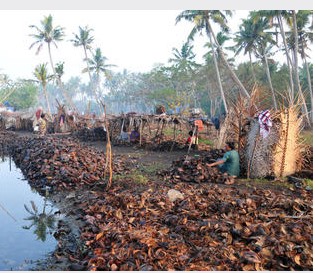Rebooting agriculture to provide clean, practical solutions to Sri Lanka’s energy crisis – II.
Posted on May 23rd, 2019
By Chandre Dharmawardana, Canada
Newspaper reports mention how the minister of Power and Energy and the CEB engineers are trying to meet a systemic power shortage looming over Sri Lanka. The Easter Sunday carnage made everyone forget about the grave systemic problems facing Sri Lanka. Sri Lanka seems to lurch from one emergency to another in every sector, like a ship gone adrift. A May 20th report in the Island states that CEB engineers warn of power cuts …”. This is a result of not staying course with long-range power production plans when governments and their favourite financiers changed. Furthermore, the CEB plans were inconsistent with rising concerns on pollution and global warming. The potential of solar- and biomass energy was considered to be unimportant when the CEB energy plans were made decades ago.
In a previous article labelled part-I that appeared in the Lanka web (http://www.lankaweb.com/news/items/2019/05/06/clean-practical-solutions-to-sri-lankas-energy-crisis-i) we examined how Solar power can provide a large part of the needed power by using floating solar panels in reservoirs already equipped with hydro-turbines and how they can be deployed to provide FIRM POWER without batteries or alternators. The proposal is to store solar electricity (or wind generated electricity) by using the alternative energy source (be it wind or solar) for re-pumping water back into the reservoirs. Then nearly the equivalent amount of electricity can then be re-generated in the usual manner by the hydro-turbines. Biomass energy offers an even bigger inexpensive source of firm energy that can be made available at will.
Ailing agricultural sectors can be re-booted inexpensively to become vibrant bio-energy industries. The potential can meet Sri Lanka’s needs for decades to come, and even to sell to the Indian continent using a cable link, breaking the isolation of Sri Lanka’s power grid.
There are mind boggling possibilities. Scientists can engineer, within the decade, whole forests with genetically modified plants that store lots more carbon than plants available today. The relevant genes are already known. Such plants can fight climate change and also greatly increase the efficiency of bio-energy plants
A READILY AVAILABLE BIO-ENERGY SOURCE.
Bio-energy has been talked of for decades, but with its implementation. There are, as yet no turn-key solutions or commission-carrying businessmen. The simplest approach is to burn any kind of fast-growing wood, bamboo, bagasse etc., in high-efficiency furnaces and run generators.
This process is carbon-neutral” as the CO2 released is that absorbed by the plants during growth. The flue gases are relatively free of the toxic nitrous and sulphurous fumes found in coal-fire or diesel emissions. There is sub-micron fly ash, although minimal compared to coal. While the logistics of collecting the biomass is big, private companies like GreenWatt in Moneragala have set up 10 MW power plants using fast-growing Gliriicidia. CEB engineers consider these as small potatoes”, but thousands of such plants can be set up easily in the plantation sector.
There are several inexpensive and efficient processes for generating energy for Sri Lankan needs for ever. Here we discuss just ONE eminently practical solution that simultaneously reboots the ailing coconut sector.
THE COCONUT INDUSTRY AS AN ENERGY GIANT.
The industry concentrates on the coconut kernel as copra and desiccated coconut. The local householder buys coconuts for cooking. The milk is hand-squeezed inefficiently. The water, the spent kernel (‘polkudu’), the shell and the husk are wasted or used in primitive highly polluting industries (e.g., making coir, rugs) with only a minimal value addition, while the demand is unsteady.
Coconut shells are indeed used as fuel or for making activated carbon. According to Paddon and Parker (1979) the husk has some 6700 kilo Joules per nut, i.e., almost 5 KWh of energy per kilo of husk! So the energy from ten husks is roughly the same as from one litre of petrol! Only part of the heat can be converted into electricity because of the Carnot-Rankin loss to entropy.
The water, kernel and the shells already have a good market value. So we use the husk and all waste for the energy sector. Sri Lanka produces approximately 2.5 billion nuts/year, a drop from its better days with 3 billion. Using the dry weight (following FAO data) of the husks, the 2.5 billion husks are equivalent of about 2 million GWh per year, i.e., some 5.3 billion liters of petrol/year.
If even 20% of the husks were collected, and if the heat-to-electricity conversion
efficiency is 30%, an energy yield of 0.3 billion liters of petrol, or about 150,000 GWh from the husk alone is possible. Taking the total annual power need of the country to be about 15,000 GWh, the coconut sector can readily supply ten times the energy needs of the country right now!
Sri Lanka’s ailing coir industry and allied industries like husk chips, coir pith (‘kohubath’) for soil remediation, `kohu’-panels, etc are simply methods of discarding valuable energy. Just as Sri Lanka throws away the coconut water, kurumba Komba” (used coconut), the potential of the husk too is wasted when used in traditional agriculture or rural industries.

The coconut husks are traditionally dumped in pits or submerged in cages near waterways for ‘retting’, prior to the fiber extraction by primitive methods dangerous to workers. The water become polluted and emits bad odors; oxygen depleted effluent full of organic matter deadly to aquatic biota are a byproduct of this industry.
Recognizing the energy potential in coconut, a different industry model must be legislated. Whole nuts should only be sparingly available in the market. Just as paddy is processed and only hulled rice is marketed, coconuts should be processed to market the kernel and shell, while the coconut water should be canned and sold. The husk is the fuel for high-efficiency burners whose heat generates electricity. The sale of individual coconuts rather than the transformed products should be highly taxed. Only those who grow coconut in their home gardens for private use can have the luxury of consuming coconuts in the traditional way. A higher price for husks will tempt everyone to sell their husks to the power company. The present ‘waste tariff’ on husks must be lifted and the power industry be given a 20-year tax credit. There can be power hundreds of companies in large coconut estates.
So we have no need for coal or liquified gas, or ransoming Sri Lanka’s sovereignty to foreign vendors, or destroying the environment, in order to be self-sufficient in energy. Similarly, mini-hydro companies should be banned as they render little and cause much ecological damage. No oil or gas exploration in the neighbouring seas should be allowed as it is intensely environmentally damaging. It will further threaten the nation’s sovereignty as has happened to many small oil-rich nations now in the grip of powerful consortia.
The coconut acreage need not increase (i.e., no habitat loss) as the current husk supply far exceeds the needs for energy production which can start within months rather than years. Those working in the ailing coir and allied industries should be absorbed into the energy sector. The ash from burning coconut husk is rich in potassium, phosphorous and other minerals.

Husk ash mixed with optimal amounts of humus and urea makes a good fertilizer. However, controls on metal toxins against bio-accumulation are needed just as with organic fertilizers. The ash is useful in the construction industry, e.g., for sand mixes, making bricks or paving stones.
Using gene technology in agriculture for carbon capture and reuse.
Coconut production itself can be increased using modern cultivars instead of traditional varieties, without incurring habitat loss and in fact aiming to return currently cultivated land back to nature. Proper fertilizer application, irrigation, and restoring the right of the coconut grower to use herbicides like glyphosate that are least harmful to the environment will increase nut production without increasing the land under cultivation. The use of so-called organic” methods based on unscientific and outdated myths that rejects the use of plant genetics etc., should be discouraged. Use of herbicides enables a drastic reduction in soil erosion and reduces manual labour.
It is interesting to note that many anti-rational ideologically motivated programs have contain in them an attack on genetics. The Marxist” agriculture of Lysenko in the Soviet Union, and the so-called organic farming” movements of today which also lean on a nostalgic throw-back to traditional agriculture” are examples of such anti-rational movements. Instead, plant genetics and biotechnology should be harvested to increase yields, be it in the output of nuts husks or any other desirable product, while decreasing the area under cultivation, thus reducing the habitat encroachment by human activity. The catastrophic decline in pollinating species, and in biodiversity in general are mostly due to habitat loss and deforestation caused by humans.
Any tree that is grown for production of energy for biomass can be genetically engineered and optimized for increased carbon capture as well as rapid growth. For instance, mangroves have developed root systems which contain various types of high-carbon cellulose. Mangroves should be preserved on their own ecological value and should NOT be exploited for their bio-mass. But we can learn from the genetic makeup of plants like Mangroves. That is, genes relevant to high carbon capture by plants that make, say, Subarin, can be transferred to many other plants using gene technology. Many young Sri lankan scientists have now acquired the scientific know how needed in biotechnology and genetic engineering. Coconut plants re-designed to make Subarin in the husk would further increase the high energy content of husks, and also add to temporary carbon storage. Such innovative solutions are needed if we are to meet to the current ecological crisis by reducing global warming, and by aggressively returning cultivated land back to nature to preserve bio-diversity, while getting ready for 11 billion humans by the end of the century.
CONCLUSION.
We have shown that effectively unlimited amounts of power are available from the waste bio-mass of the coconut industry. A similar analysis will be presented in a future article, showing that Rubber, Paddy, or maize etc., can become lucrative energy giants. Genetically engineered carbon-rich plants can boost the energy harvest enormously, while also scavenging out green-house gases.
[The Author was a past-Professor of Chemistry and a Vice-Chancellor of the SJP University in the 1970s. He is currently a Professor of Physics in Canada.]
May 24th, 2019 at 6:24 pm
Prof Dharmawardena, I agree with you. Instead of coal plants this is exactly what we should be doing. The politicians love coal plants since it brings a steady income for coal commissions.